
HMS Beagle was a wooden-hulled Arrow-class gunvessel second-class screw gunvessel launched in 1854 and sold in 1863. She was the third vessel of the Royal Navy to use the name.

The Algerine-class gunboats were a class of six 3-gun wooden gunboats built for the Royal Navy in 1857. A further pair were built in India for the Bombay Marine in 1859.

The Arrow class comprised six second-class screw-driven vessels built as dispatch vessels for the Royal Navy in 1854, mounting 6 guns. In 1856 they were redesignated as second-class gunvessels.

HMS Surprise was a Vigilant-class gunvessel of the Royal Navy. She was launched at Blackwall Yard, London in 1856 and broken up in Plymouth in 1866.

HMS Sparrowhawk was a Vigilant-class second-class despatch/gunvessel launched on 9 February 1856 at Limehouse, England and served at various stations in the Far East. By the spring of 1865, her rig was a converted to that of a three-masted barque. She was sold in 1872, converted to a sailing barque in mercantile service, and was later a coal lighter in Australia.

HMS Eclipse was a four-gun Cormorant-class first-class gunvessel launched in 1860 from the shipyard of J. Scott Russell & Co., Millwall. She served on the Australia Station, took part in the Second Taranaki War, including contributing men to a naval brigade which attacked the Maori stronghold at Gate Pā. The entire class were never satisfactory as gunvessels, partly due to their excessive draught, and Eclipse was broken up at Sheerness in 1867, only seven years after her launch.
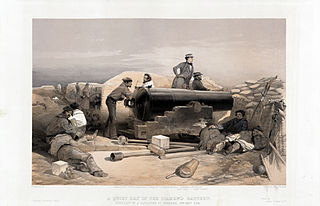
68-pounder Lancaster guns were a British rifled muzzle-loading cannon of the 1850s that fired a 68-pound shell. They were fitted in pairs to the Arrow-class gunvessel. The cannon was designed with an oval bore and had a range of about 6500 yards. The gun had a tendency to burst.

The 68-pounder cannon was an artillery piece designed and used by the British Armed Forces in the mid-19th century. The cannon was a smoothbore muzzle-loading gun manufactured in several weights, the most common being 95 long cwt (4,800 kg), and fired projectiles of 68 lb (31 kg). Colonel William Dundas designed the 112 cwt version in 1841 and it was cast the following year. The most common variant, weighing 95 cwt, dates from 1846. It entered service with the Royal Artillery and the Royal Navy and saw active service with both arms during the Crimean War. Over 2,000 were made and it gained a reputation as the finest smoothbore cannon ever made.
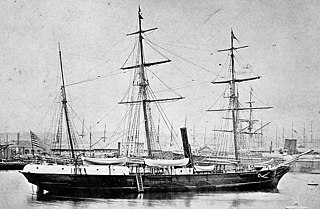
The Philomel-class gunvessel was a class of wooden-hulled screw-driven second-class gunvessels built for the Royal Navy between 1859 and 1867, of which 26 were ordered but only 20 completed. They had a mixed history, with some serving for as little as 5 years, and others surviving into the 1880s. Two of the class were sold and used as Arctic exploration vessels, both eventually being lost in the ice.

HMS Myrmidon was a Cormorant-class gunvessel of the Royal Navy, built at Chatham Dockyard and launched in 1867. She served on the North America and West Indies Station and surveyed parts of the Australian coast before being sold at Hong Kong in 1889.
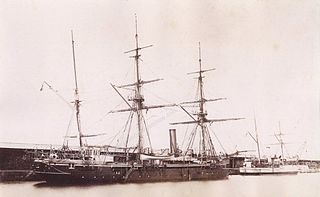
HMS Rambler was an Algerine-class gunvessel of the Royal Navy, built by John Elder & Co., Glasgow and launched on 26 January 1880. She was commissioned as a survey vessel in 1884 and served in Chinese waters during the 1880s and 1890s. She provided men to a naval brigade during the Boer War and was sold on 23 January 1907. The work of this vessel is now remembered in Hong Kong by the Rambler Channel near Tsing Yi.

The Ariel-class gunboat was a class of nine 4-gun composite gunboats built for the Royal Navy between 1871 and 1873. Although most were sold by 1890, one of them survived into the 1920s as a salvage vessel in private ownership. They were the first class of Royal Navy gunboat built of composite construction, that is, with iron keel, stem and stern posts, and iron framing, but planked with wood.

The Algerine-class gunvessel was a class of three Royal Navy composite gunvessels built in 1880. Two of them were sold after only ten years of service, but the other was converted to a survey ship before commissioning and survived in this role until 1907.
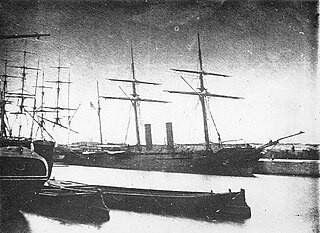
Intrepid-class gunvessels were a class of six Royal Navy first-class wooden gunvessels built in 1855-56. They were rated as sloops from 1859 to 1862, and were scrapped by 1865. Victor was sold to the Confederate States of America as the raider CSS Rappahannock, but she was interned by the French at Calais and never fulfilled her intended function.

HMS Jaseur was an Algerine-class gunboat launched in 1857. She served on the North America and West Indies station for less than two years before her loss by stranding on the Bajo Nuevo Bank in the Caribbean on 26 February 1859.
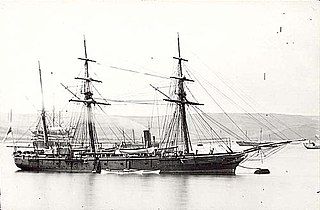
The Arab-class gunvessels were a pair of composite gunboats built for the Royal Navy in the mid-1870s.

The Britomart-class gunboat was a class of sixteen gunboats built for the Royal Navy in 1859–1867.

The Forester-class gunboat was a class of 4-gun composite gunboats built for the Royal Navy between 1874 and 1877. Although half had been sold by 1890, the rest survived into the 20th century as coal hulks, base vessels and other secondary uses. Foxhound survived as a hulk on the Blackwall Reach of the Thames until 1975, when she was broken up. They were built of composite construction, that is, with iron keel, stem and stern posts, and iron framing, but planked with wood.

The Cormorant-class gunvessels were a class of 4-gun first-class gunvessels built for the Royal Navy in the 1860s. They were somewhat unsuccessful; intended for shore bombardment in shallow water, they exceeded their design draft by 50%. Seven of the 13 ships ordered were suspended, with 3 finished or converted as survey ships and the other 4 cancelled. Racehorse was wrecked after only 4 years, and those ships that were completed as planned had short operational lives, in some cases less than 10 years. The survey vessels lasted longest, with the last ship of the class, Sylvia, being broken up in 1890.
HMS Ringdove was a Vigilant-class gunvessel of the Royal Navy. She was launched by J. Samuel White, Cowes in 1856 and broken up in Cowes in 1866.














